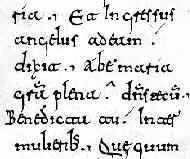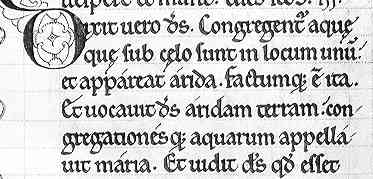




If you are looking at this page without frames, there is more information about medieval writing to be found by going to the home page (framed) or the site map (no frames).
| Punctuation (2) | |||
|
|
|||
 |
|||
| Two segments from a page of an 8th century martyrology written in insular minuscule script (Paris. Bibliothèque Nationale, MS Lat. 10837, f.8). (From New Palaeographical Society 1910) | |||
| The above example shows a number of distinctive features of formatting and punctuation by the scribes of insular minuscule. Punctuation marks consisting of single dots, or groups of three dots, and slashes are employed. The marks are repeated to indicate the degree of emphasis or length of pause that they imply. A small zigzag mark, seen on the bottom line of each segment at the end of a row of dots, was used in many scripts to indicate the end of a section. Here it is part of sequences of marks which show the exact weight of the pause.. | |||
| The beginnings of sections are indicated by enlarged and adorned capital letters, but a particular feature of insular minuscule is the sequence of letters gradually decreasing in size that follows each one, making it look as if each section has been somehow wedged into the text. | |||
| A feature which is found in writing throughout the middle ages is the use of abbreviation marks. These slashes above and through letters can be seen as a form of punctuation, as they are graphical devices for interpreting the text, indicating where words have been abbreviated. | |||
 |
The diverse assortment of minuscule scripts which predated Caroline minuscule, sometimes known as the National Hands, each developed their particular range of dots, slashes and squiggles to indicate pauses of different length and weight. There are three different combinations in the snatch of Visigothic minuscule shown at left, as well as an elaborate abbreviation mark. Both Visigothic and Beneventan minuscule employed a rather complex range of punctuation marks. | ||
| Visigothic script from a 10th century volume of Mozarabic liturgy (British Library, add. ms. 30844). By permission of the British Library. | |||
 |
|||
| Segment from an 8th century copy of the Epistles of St Cyprian (Manchester, The John Rylands Library, MS Lat.15, f.48b). (From New Palaeographical Society 1909) | |||
| The above sample of a pre-Carolingian hand shows a dot and slash (after remitto, top line), a double dot (after suis, bottom line) and single dots (three of them, you find them). It also has abbreviation marks in the form of horizontal and diagonal lines, as well as slashes through letters. | |||
| The scribes of the monastery of Corbie and of the royal library of Charlemagne are credited with the invention of the question mark. It came in a range of forms, but has been equated in general appearance with a form of musical notation which indicated a kind of rising trill between notes. This is another little hint which implies reading aloud, where the sign for interrogation is equated with the voice inflection used for expressing it. | |||
| Question mark in a early 9th century Lives of the Fathers (Brussels, Bibliothèque Royale MS 8216-18, f.85). (From Steffens 1929) | |||
| In the above example, the script is Caroline minuscule. It reads Ubi uadis? | |||
| Question mark in an early 12th century protogothic script, from a Life of St Mildred (British Library, Cotton Vespasian B XX, f.167b). (From New Palaeographical Society 1906) | |||
| By the 9th century some scriptoria had simplified their punctuation code, and by the 11th century the standard form for liturgical manuscripts involved just two different marks for different weights of pause. An introduction of around the 11th century was a form of hyphen to indicate words which continued to the next line. Various accents also appeared in different forms at various times to indicate stressed or long syllables. Once again this implies reading aloud. The Cistercians developed a more complex range of punctuation marks for books that were read aloud in the refectory, and these were adopted by the Dominicans for their books that were read aloud during liturgy. | |||
 |
Segment from a large and formal late 12th century Bible (Paris, Bibliothèque St Geneviève, MS 8-10). (From New Palaeographical Society 1907) | ||
| The above example shows two forms of pause, a single dot and a dot with slash above it. It has hyphens where words continue to the next line, abbreviation marks and both subscript and superscript accents on some vowels. There are capital letters after major pauses and enlarged capitals at the beginning of each paragraph. Taken all together, this represents quite a complex code for interpretation and presentation of the text in addition to the basic alphabetical code with defines it. | |||
| There are people today who decry the modern habit of simplified, sloppy or "incorrect" punctuation. Does this imply that we now have such a familiar and sophisticated relationship with the written word that we no longer require such formal and complex props for its interpretation? I leave the question mark in for emphasis. | |||
|
|
|||
|
|
|||
|
If you are looking at this page without frames, there is more information about medieval writing to be found by going to the home page (framed) or the site map (no frames). |
|||